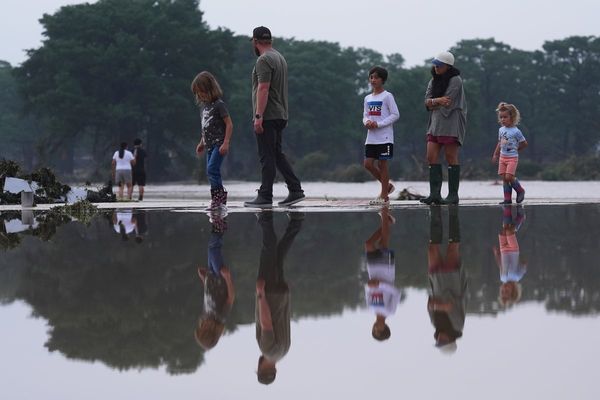
Last week, just before his Autumn/Winter 2016 collection show in Paris, designer Rahul Mishra was asked by the Yahoo! website which famous person could best embody his clothes. “I would love to dress Tilda Swinton as she has the ability to convey intense strength and tantalizing fragility,” said Mishra, rather grandly.
The question was incisive. It had two purposeful elements of fashion, “famous” and “embody”, probing the notion of a distinctive muse who instils life into clothes. Swinton, the British actor, performance artiste and model with platinum hair and eccentric style—called out for her “tandoori tan” in her role as a fashion magazine editor in the film Trainwreck last year—may or may not wear Mishra’s clothes. But a fashion designer’s need to align himself to a rebellious or romantic persona is not so common any more.
Before the curtains go up on the Amazon India Fashion Week’s (AIFW’s) Autumn/Winter 2016 edition in Delhi next week, designer Varun Bahl, who will present the opening show, muses over the fading of the muse. “Having a muse was big once upon a time. It served its purpose. It is now a thing of the past. Today designers want to reach out to a wider audience. I want to capture the needs of the emerging customer,” he says.
Bahl, whose bridal wear was featured in The New York Times in January as part of 10 distinct wedding outfits across the world, says having social media marketing, Instagram and an inclusive (instead of exclusive) approach to fashion is more important than a muse.
The fashion system has changed. And almost as a reflex action, so has fashion communication. A single person as the face of a brand now seems like an outdated idea. The campaigns by top Indian couturiers splashed in fashion magazines most often feature a crowd wearing Indian regalia—men and women with a child or two and, sometimes, a senior lady with salt and pepper hair thrown in. Most showcase bridal garments, clearly indicative of market demands. Anita Dongre, Tarun Tahiliani, Ritu Kumar, Sabyasachi and Manish Malhotra, to name a few, all use a number of different models in their advertising. They are clearly reaching out to a larger base of customers. It is about a group; a community without one, identifiable face. When there is a showstopper or a celebrity at a special event, it is usually the Hindi cinema actor with a film release coming up. “All said and done, Bollywood helps carry the message across and the fashion media only responds to film stars,” insists Bahl.
Then there is social media. Younger designers who don’t advertise, or can’t afford to, say their marketing is taken care of by girls of the Snapchat and selfie generation, Instagram addicts, Facebook fashionistas, and other tech-savvy tribes. Every society glamour girl and college girl is a muse and a model. They don’t need to gaze at Kate Moss or Kangana Ranaut; instead, they want to be “like” them.
So even if younger designers such as Anand Bhushan, Rimzim Dadu, Aneeth Arora and Ruchika Sachdeva don’t advertise, fashion followers know what their clothes look like. Dadu, who is also showing next week at the AIFW in Delhi, shrugs off the muse baggage totally. “I don’t even connect with fashion,” she says. “I see myself as someone who works with textiles and different surfaces. I would rather regular people wear and appreciate my work. Who am I to say that there is a certain Rimzim Dadu look?” she says. In contrast to designers who look for known models, Dadu tries to pick fresh, unknown faces.

There are other examples. Model-turned-actor Arjun Rampal was Rohit Bal’s muse for many years and still walks for him on special occasions. Bal himself is the muse for Linen Club, a house of linen fabrics. Wendell Rodricks has had a creatively fiery relationship with model and actor Malaika Arora. Rodricks’ muse for years, Arora was on the cover of his autobiographical book, The Green Room. Memories of her breathing fire into his early work are frozen in the breathtakingly glamorous photographs showcased at his Goa home.
The muse-photographer relationship found a romantic dimension in the work of the late photographer Prabuddha Dasgupta and model Lakshmi Menon—they created magic together. Shot by Dasgupta, Menon became the “face” of bold ideas in fashion in the 2000s. Sometimes, she just wore traditional jewellery with her attitude on her sensuously photographed body.
It was a brief phase in India but in the West, the narrative of 20th century fashion was dominated by the “muse”. Some of these are legendary: Hollywood actor Audrey Hepburn for Hubert de Givenchy, an association that led to fitted shift dresses and low, ladylike pumps; pop music stars Madonna and David Bowie for French designer Jean Paul Gaultier, which led to museum-worthy interpretations of the conical bra and the star-spangled jumpsuit, respectively; and fashion editor Isabella Blow’s saucer hats and fascinators by Irish master milliner Philip Treacy. Each represented a slice of rebellion against fashion orthodoxy or started a “trend”.One of Gaultier’s muses—French-Canadian model Ève Salvail—created shock waves in the early 1990s when she walked the ramp with a tonsured head, challenging preconceived notions of beauty. Like Twiggy, the model who ended up being known as the Face of the Sixties for her skinny, fragile look. Fashion’s enfant terrible John Galliano, creative director of Dior for many years, got written about as a muse-like personality himself. He famously wore red nail paint on his toenails (with matted hair, black T-shirts, even a sari once) to his meetings. His muses ranged from fashion visionary Amanda Harlech to crazy, abstract ideas. In 2011, when asked about his muse, he told the New York magazine: “She’s always elusive. I’m always chasing her. She’s an essence, a spirit. Like a parfum. I don’t really ever want to catch her because that’s what keeps me going.”
The word muse has been seen as an agent provocateur in creative professions. American author Elizabeth Gilbert’s memorable TED talk on ideas, Your Elusive Creative Genius, spoke about the muse as a genius, a divine experience that impels people—poets, writers, musicians, painters—to follow the dictates of a paranormal force. But the fashion muse—different from passing inspirations for designers like the Maasai tribe, the British aristocracy or the victimization of inmates at the Abu Ghraib prison (portrayed in a John Galliano menswear collection)—was about divas who gave reason and rhapsody to couture.


The Indian fashion industry has moved in a different direction. One is “accessible” fashion, which means everything created by everyone for online stores, multiple fashion weeks, small-town boutiques and sponsored bridal shows. This kind of fashion is porous, visible, and available on social media. It shows a commercial desperation but it embraces all. “An individual is no longer the driver of a brand,” points out designer Narendra Kumar, the creative director at e-commerce firm Amazon India. “Even big brands have had to widen their base. Designers have realized there is greater longevity by making their approach inclusive. Attitude is no longer to be beamed out through a person but through clothes,” says Kumar, adding that the retail industry in India has not supported its designers. “It is financially unviable to keep any brand exclusive. The decline of the muse is the effect of this market transition on designers.”
The sales of Indian fashion, despite all the hype, fashion weeks and film stars ready to endorse anyone, have been falling. In 2015, Indian prêt sales shrank by 15-30% for a majority of designers, according to their own admission. Even bridal wear, seen as the only secure commercial segment, scaled down 10-20%. An exclusive muse with an attitude is of little use in this environment.
While there is much noise about designers working with textiles and handlooms, there is no recognizable face to visually hold up Indian weaves as contemporary fashion. Incredible India as a tourist destination may get Priyanka Chopra but would an A-list celebrity “embody” the ministry of textiles?
That’s why designer Sabyasachi’s new flagship store in Delhi, so rich with Indian crafts and wonderfully linked to his home state West Bengal, is a modern-day muse. Sabyasachi has changed his inspiration, from a person to a space.
When you sift through what the fashion industry has lost and found, Rodricks rings in with reason. “A muse may change over the years. For me, it was Malaika Arora, then it was Anjana Sharma. Malaika grew as a lady and as a mother and I had to address that fact in my mind. Today it is the Indian woman who is central to my creative core, who is my muse. I am watching her carefully, including how she rolls up her sleeves through FB (Facebook) or Instagram. Personally, I think we all still have our muse(s). The discussion has just fallen into the public domain because of technology.”While clothes may not sell more if Shubha Mudgal sings alongside a show (as she did for Sabyasachi in 2011 and Rohit Bal in 2014) or if actor Tabu dressed as Draupadi walks for an Anju Modi show (as she did in 2013), it’s now up to consumers to separate fashion’s voice from its noise.












